2021 TOYOTA PROACE CITY VERSO instrument panel
[x] Cancel search: instrument panelPage 83 of 272
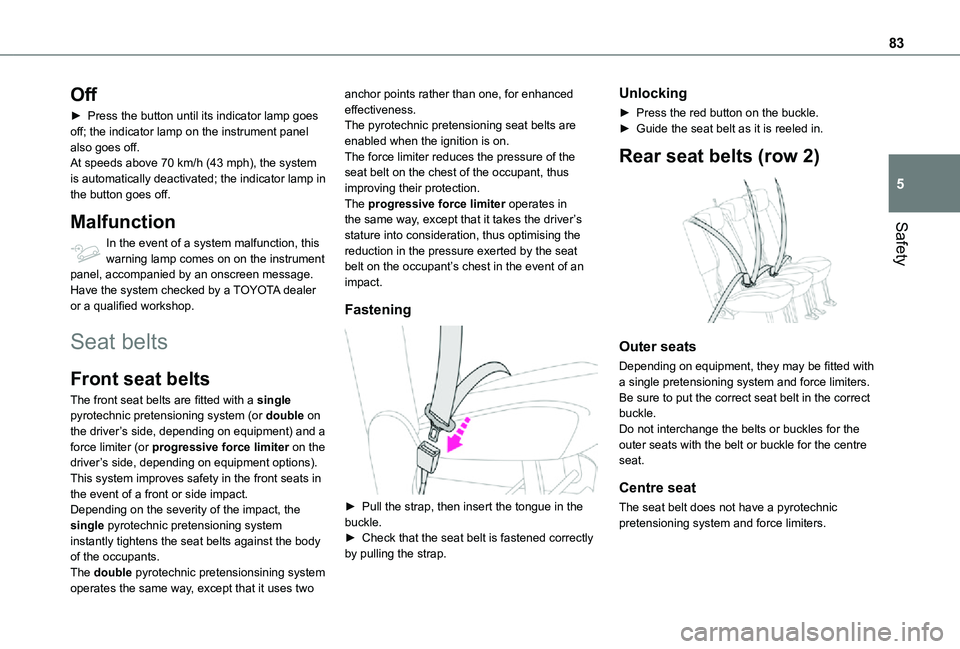
83
Safety
5
Off
► Press the button until its indicator lamp goes off; the indicator lamp on the instrument panel also goes off.At speeds above 70 km/h (43 mph), the system is automatically deactivated; the indicator lamp in the button goes off.
Malfunction
In the event of a system malfunction, this warning lamp comes on on the instrument panel, accompanied by an onscreen message.Have the system checked by a TOYOTA dealer or a qualified workshop.
Seat belts
Front seat belts
The front seat belts are fitted with a single pyrotechnic pretensioning system (or double on the driver’s side, depending on equipment) and a
force limiter (or progressive force limiter on the driver’s side, depending on equipment options).This system improves safety in the front seats in the event of a front or side impact.Depending on the severity of the impact, the single pyrotechnic pretensioning system instantly tightens the seat belts against the body of the occupants.The double pyrotechnic pretensionsining system operates the same way, except that it uses two
anchor points rather than one, for enhanced effectiveness.The pyrotechnic pretensioning seat belts are enabled when the ignition is on.The force limiter reduces the pressure of the seat belt on the chest of the occupant, thus improving their protection.The progressive force limiter operates in the same way, except that it takes the driver’s stature into consideration, thus optimising the reduction in the pressure exerted by the seat belt on the occupant’s chest in the event of an impact.
Fastening
► Pull the strap, then insert the tongue in the buckle.► Check that the seat belt is fastened correctly by pulling the strap.
Unlocking
► Press the red button on the buckle.► Guide the seat belt as it is reeled in.
Rear seat belts (row 2)
Outer seats
Depending on equipment, they may be fitted with a single pretensioning system and force limiters.Be sure to put the correct seat belt in the correct buckle.Do not interchange the belts or buckles for the outer seats with the belt or buckle for the centre seat.
Centre seat
The seat belt does not have a pyrotechnic pretensioning system and force limiters.
Page 84 of 272

84
Installation
► Pull the strap and insert the tongue A into the right buckle (located on the passenger’s left side when seated in the vehicle).► Insert the tongue B into the left buckle (located on the passenger’s right side when seated in the vehicle).► Check that each buckle is fastened correctly by pulling the strap.
Removal and storage
► Press the red button on buckle B, then the button on buckle A.► Guide the strap as it reels in and take tongue
B, then A to the magnet at the anchoring point on the roof.
WARNI NG
Before performing any operations on the rear seats, to avoid damage to the seat belts check that the lateral belts are properly tensioned. The central seat belt must be completely reeled in.
Rear seat belts (row 3)
These seat belts are not fitted with a pyrotechnic pretensioning system or force limiter.
Seat belt(s) warning lamps
1.Front left seat belt warning lamp (or depending on country, driver’s warning lamp).
2.Front right seat belt warning lamp (or depending on country, driver’s warning lamp).
3.Rear right seat belt warning lamp (row 2).
4.Rear centre seat belt warning lamp (row 2).
5.Rear left seat belt warning lamp (row 2).
At speeds above approximately 20 km/h (12 mph), the warning lamp(s) flashes for 2 minutes, accompanied by an audible signal. Once these 2 minutes have elapsed, the warning lamp(s) remains on until the driver or the front passenger and/or the rear passenger(s) fasten their seat belt.
Front seat belt warning lamp(s)
On switching on the ignition, warning lamp 1 comes on in the instrument panel, and the corresponding warning lamp (1 or 2) comes on in red in the seat belt and front passenger airbag warning lamp display if the driver's seat belt and/or the passenger(s) seat belt is/are not fastened or is/are unfastened.
Rear seat belt(s) warning lamp(s)
The corresponding warning lamp (3 to 5) lights up red in the seat belt and front passenger airbag warning lamps display screen if one or more rear passengers (row 2) unfasten their seat belt.
Page 87 of 272
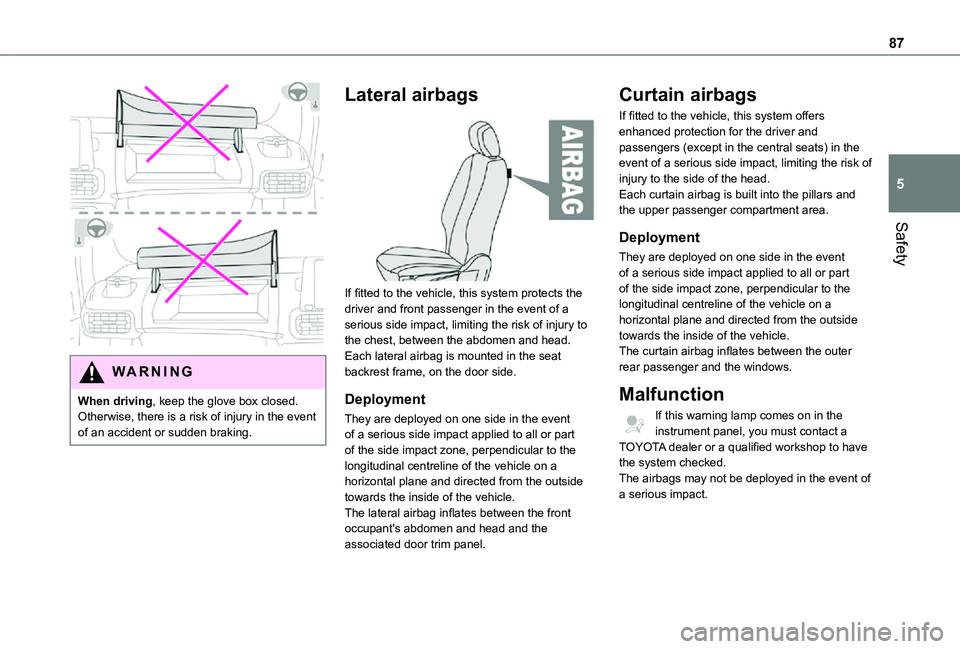
87
Safety
5
WARNI NG
When driving, keep the glove box closed. Otherwise, there is a risk of injury in the event of an accident or sudden braking.
Lateral airbags
If fitted to the vehicle, this system protects the driver and front passenger in the event of a serious side impact, limiting the risk of injury to the chest, between the abdomen and head.Each lateral airbag is mounted in the seat backrest frame, on the door side.
Deployment
They are deployed on one side in the event of a serious side impact applied to all or part
of the side impact zone, perpendicular to the longitudinal centreline of the vehicle on a horizontal plane and directed from the outside towards the inside of the vehicle.The lateral airbag inflates between the front occupant's abdomen and head and the associated door trim panel.
Curtain airbags
If fitted to the vehicle, this system offers enhanced protection for the driver and passengers (except in the central seats) in the event of a serious side impact, limiting the risk of injury to the side of the head.Each curtain airbag is built into the pillars and the upper passenger compartment area.
Deployment
They are deployed on one side in the event of a serious side impact applied to all or part of the side impact zone, perpendicular to the longitudinal centreline of the vehicle on a horizontal plane and directed from the outside towards the inside of the vehicle.The curtain airbag inflates between the outer rear passenger and the windows.
Malfunction
If this warning lamp comes on in the instrument panel, you must contact a
TOYOTA dealer or a qualified workshop to have the system checked.The airbags may not be deployed in the event of a serious impact.
Page 101 of 272
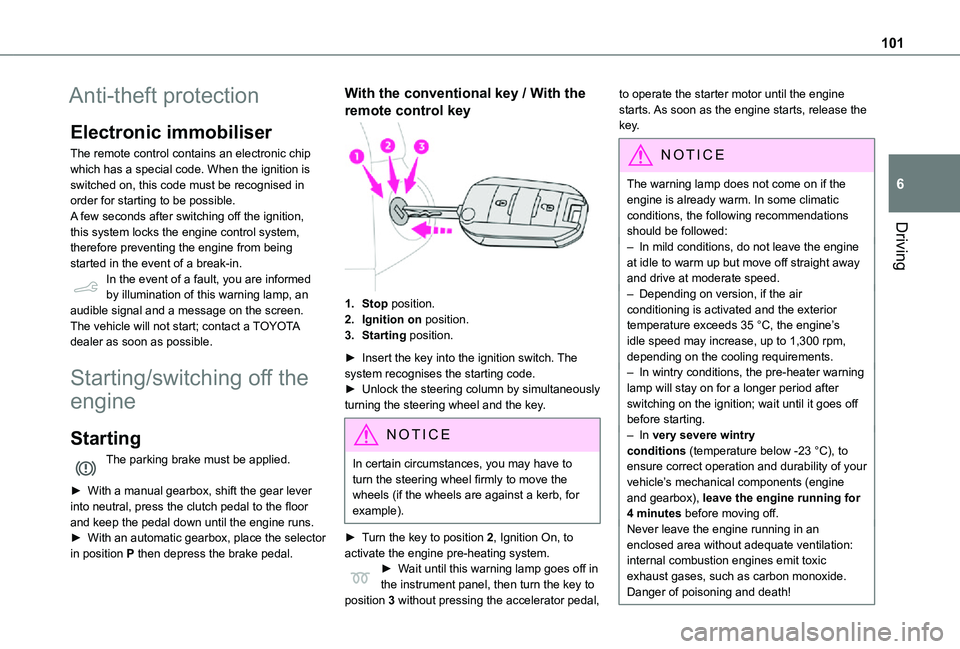
101
Driving
6
Anti-theft protection
Electronic immobiliser
The remote control contains an electronic chip which has a special code. When the ignition is switched on, this code must be recognised in order for starting to be possible.A few seconds after switching off the ignition, this system locks the engine control system, therefore preventing the engine from being started in the event of a break-in.In the event of a fault, you are informed by illumination of this warning lamp, an audible signal and a message on the screen.The vehicle will not start; contact a TOYOTA dealer as soon as possible.
Starting/switching off the
engine
Starting
The parking brake must be applied.
► With a manual gearbox, shift the gear lever into neutral, press the clutch pedal to the floor and keep the pedal down until the engine runs.► With an automatic gearbox, place the selector in position P then depress the brake pedal.
With the conventional key / With the
remote control key
1.Stop position.
2.Ignition on position.
3.Starting position.
► Insert the key into the ignition switch. The system recognises the starting code.► Unlock the steering column by simultaneously turning the steering wheel and the key.
NOTIC E
In certain circumstances, you may have to turn the steering wheel firmly to move the wheels (if the wheels are against a kerb, for example).
► Turn the key to position 2, Ignition On, to activate the engine pre-heating system.► Wait until this warning lamp goes off in the instrument panel, then turn the key to
position 3 without pressing the accelerator pedal,
to operate the starter motor until the engine starts. As soon as the engine starts, release the key.
NOTIC E
The warning lamp does not come on if the engine is already warm. In some climatic conditions, the following recommendations should be followed:
– In mild conditions, do not leave the engine at idle to warm up but move off straight away and drive at moderate speed.– Depending on version, if the air conditioning is activated and the exterior temperature exceeds 35 °C, the engine’s idle speed may increase, up to 1,300 rpm, depending on the cooling requirements.– In wintry conditions, the pre-heater warning lamp will stay on for a longer period after switching on the ignition; wait until it goes off before starting.– In very severe wintry conditions (temperature below -23 °C), to ensure correct operation and durability of your vehicle’s mechanical components (engine and gearbox), leave the engine running for 4 minutes before moving off.Never leave the engine running in an enclosed area without adequate ventilation: internal combustion engines emit toxic exhaust gases, such as carbon monoxide. Danger of poisoning and death!
Page 103 of 272
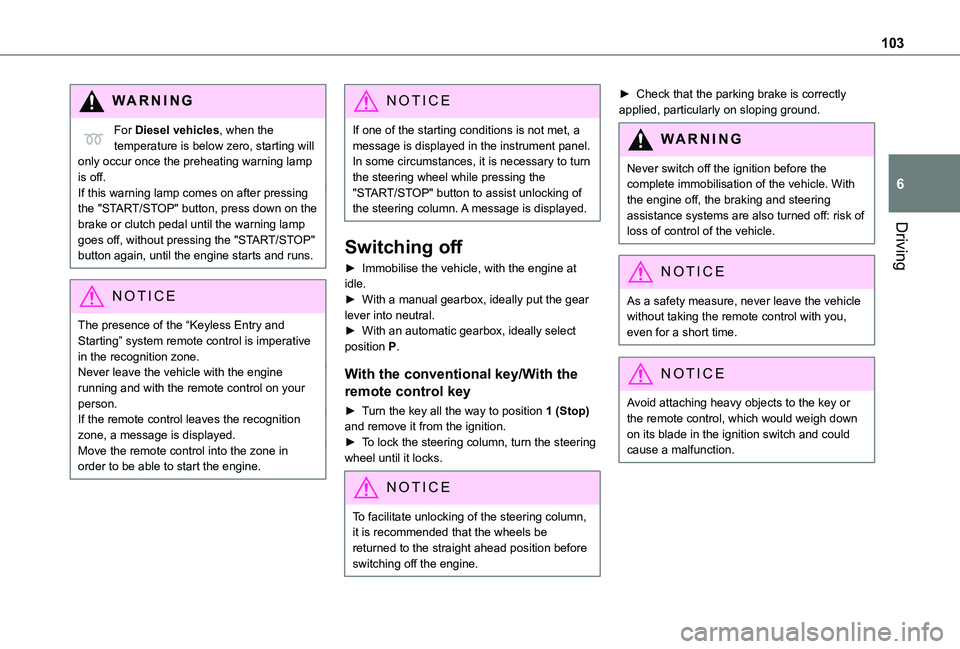
103
Driving
6
WARNI NG
For Diesel vehicles, when the temperature is below zero, starting will only occur once the preheating warning lamp is off.If this warning lamp comes on after pressing the "START/STOP" button, press down on the brake or clutch pedal until the warning lamp goes off, without pressing the "START/STOP" button again, until the engine starts and runs.
NOTIC E
The presence of the “Keyless Entry and Starting” system remote control is imperative in the recognition zone.Never leave the vehicle with the engine running and with the remote control on your person.If the remote control leaves the recognition zone, a message is displayed.Move the remote control into the zone in order to be able to start the engine.
NOTIC E
If one of the starting conditions is not met, a message is displayed in the instrument panel. In some circumstances, it is necessary to turn the steering wheel while pressing the "START/STOP" button to assist unlocking of the steering column. A message is displayed.
Switching off
► Immobilise the vehicle, with the engine at idle.► With a manual gearbox, ideally put the gear lever into neutral.► With an automatic gearbox, ideally select position P.
With the conventional key/With the
remote control key
► Turn the key all the way to position 1 (Stop) and remove it from the ignition.► To lock the steering column, turn the steering
wheel until it locks.
NOTIC E
To facilitate unlocking of the steering column, it is recommended that the wheels be returned to the straight ahead position before switching off the engine.
► Check that the parking brake is correctly applied, particularly on sloping ground.
WARNI NG
Never switch off the ignition before the complete immobilisation of the vehicle. With the engine off, the braking and steering assistance systems are also turned off: risk of loss of control of the vehicle.
NOTIC E
As a safety measure, never leave the vehicle without taking the remote control with you, even for a short time.
NOTIC E
Avoid attaching heavy objects to the key or the remote control, which would weigh down on its blade in the ignition switch and could cause a malfunction.
Page 104 of 272
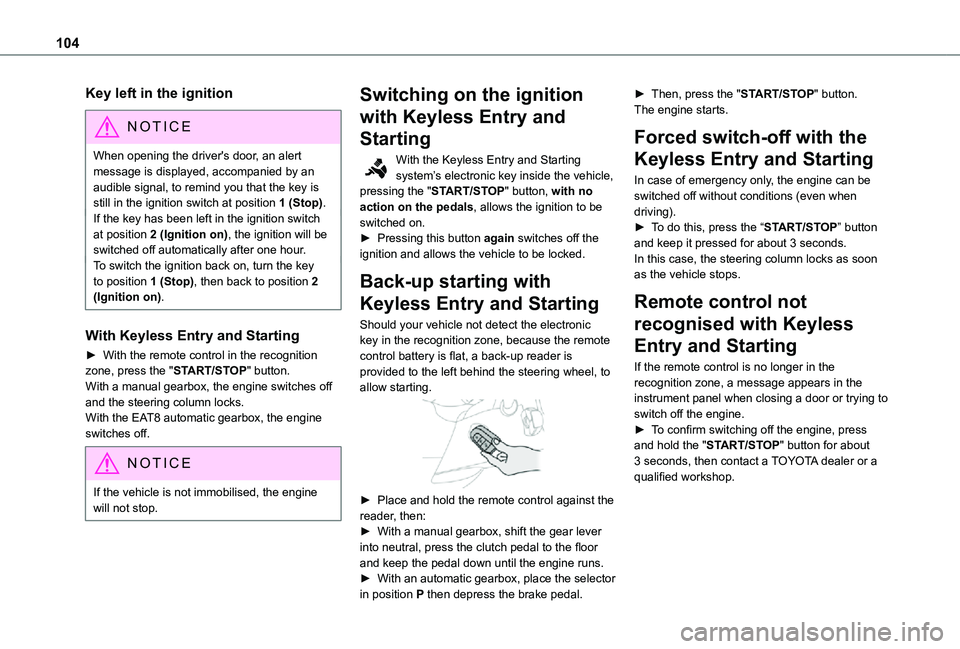
104
Key left in the ignition
NOTIC E
When opening the driver's door, an alert message is displayed, accompanied by an audible signal, to remind you that the key is still in the ignition switch at position 1 (Stop).If the key has been left in the ignition switch at position 2 (Ignition on), the ignition will be
switched off automatically after one hour.To switch the ignition back on, turn the key to position 1 (Stop), then back to position 2 (Ignition on).
With Keyless Entry and Starting
► With the remote control in the recognition zone, press the "START/STOP" button.With a manual gearbox, the engine switches off and the steering column locks.With the EAT8 automatic gearbox, the engine switches off.
NOTIC E
If the vehicle is not immobilised, the engine will not stop.
Switching on the ignition
with Keyless Entry and
Starting
With the Keyless Entry and Starting system’s electronic key inside the vehicle, pressing the "START/STOP" button, with no action on the pedals, allows the ignition to be switched on.► Pressing this button again switches off the ignition and allows the vehicle to be locked.
Back-up starting with
Keyless Entry and Starting
Should your vehicle not detect the electronic key in the recognition zone, because the remote control battery is flat, a back-up reader is provided to the left behind the steering wheel, to allow starting.
► Place and hold the remote control against the reader, then:► With a manual gearbox, shift the gear lever into neutral, press the clutch pedal to the floor and keep the pedal down until the engine runs.► With an automatic gearbox, place the selector in position P then depress the brake pedal.
► Then, press the "START/STOP" button.The engine starts.
Forced switch-off with the
Keyless Entry and Starting
In case of emergency only, the engine can be switched off without conditions (even when driving).► To do this, press the “START/STOP” button and keep it pressed for about 3 seconds.In this case, the steering column locks as soon as the vehicle stops.
Remote control not
recognised with Keyless
Entry and Starting
If the remote control is no longer in the recognition zone, a message appears in the instrument panel when closing a door or trying to switch off the engine.► To confirm switching off the engine, press
and hold the "START/STOP" button for about 3 seconds, then contact a TOYOTA dealer or a qualified workshop.
Page 105 of 272
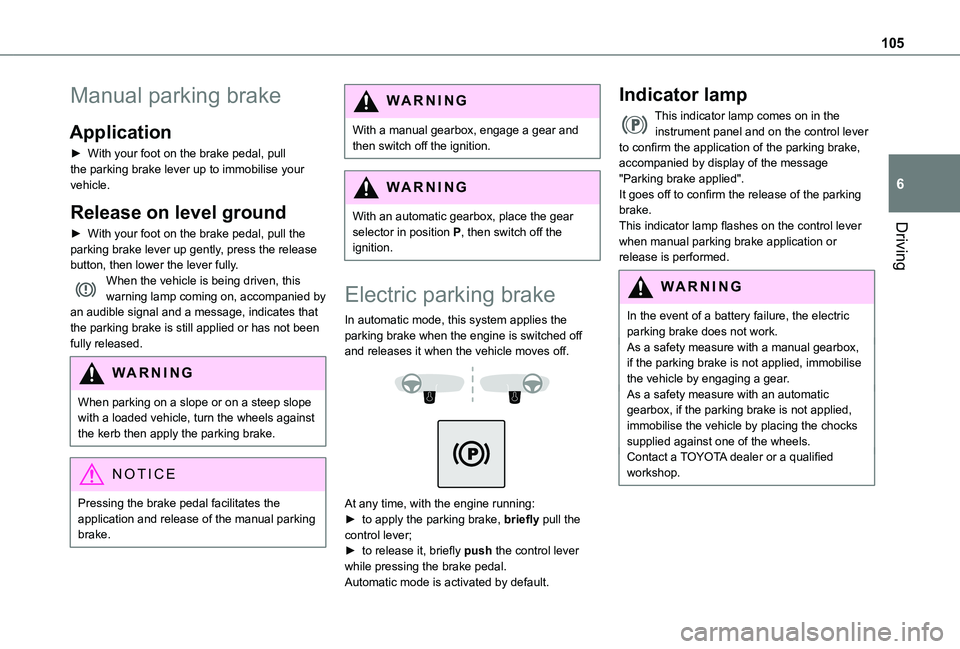
105
Driving
6
Manual parking brake
Application
► With your foot on the brake pedal, pull the parking brake lever up to immobilise your vehicle.
Release on level ground
► With your foot on the brake pedal, pull the parking brake lever up gently, press the release button, then lower the lever fully.When the vehicle is being driven, this warning lamp coming on, accompanied by an audible signal and a message, indicates that the parking brake is still applied or has not been fully released.
WARNI NG
When parking on a slope or on a steep slope with a loaded vehicle, turn the wheels against the kerb then apply the parking brake.
NOTIC E
Pressing the brake pedal facilitates the application and release of the manual parking brake.
WARNI NG
With a manual gearbox, engage a gear and then switch off the ignition.
WARNI NG
With an automatic gearbox, place the gear selector in position P, then switch off the ignition.
Electric parking brake
In automatic mode, this system applies the parking brake when the engine is switched off and releases it when the vehicle moves off.
At any time, with the engine running:► to apply the parking brake, briefly pull the control lever;► to release it, briefly push the control lever while pressing the brake pedal.Automatic mode is activated by default.
Indicator lamp
This indicator lamp comes on in the instrument panel and on the control lever to confirm the application of the parking brake, accompanied by display of the message "Parking brake applied".It goes off to confirm the release of the parking brake.This indicator lamp flashes on the control lever when manual parking brake application or release is performed.
WARNI NG
In the event of a battery failure, the electric parking brake does not work.As a safety measure with a manual gearbox, if the parking brake is not applied, immobilise the vehicle by engaging a gear.As a safety measure with an automatic gearbox, if the parking brake is not applied, immobilise the vehicle by placing the chocks supplied against one of the wheels.Contact a TOYOTA dealer or a qualified workshop.
Page 106 of 272
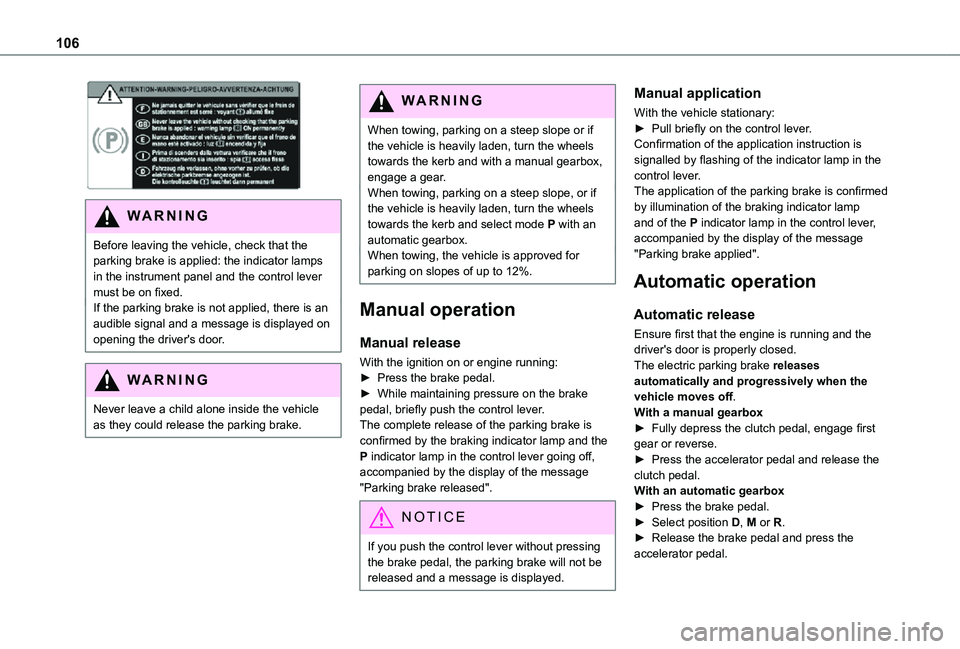
106
WARNI NG
Before leaving the vehicle, check that the parking brake is applied: the indicator lamps in the instrument panel and the control lever must be on fixed.If the parking brake is not applied, there is an audible signal and a message is displayed on opening the driver's door.
WARNI NG
Never leave a child alone inside the vehicle as they could release the parking brake.
WARNI NG
When towing, parking on a steep slope or if the vehicle is heavily laden, turn the wheels towards the kerb and with a manual gearbox, engage a gear.When towing, parking on a steep slope, or if the vehicle is heavily laden, turn the wheels towards the kerb and select mode P with an automatic gearbox.When towing, the vehicle is approved for parking on slopes of up to 12%.
Manual operation
Manual release
With the ignition on or engine running:► Press the brake pedal.► While maintaining pressure on the brake pedal, briefly push the control lever.The complete release of the parking brake is confirmed by the braking indicator lamp and the
P indicator lamp in the control lever going off, accompanied by the display of the message "Parking brake released".
NOTIC E
If you push the control lever without pressing the brake pedal, the parking brake will not be released and a message is displayed.
Manual application
With the vehicle stationary:► Pull briefly on the control lever.Confirmation of the application instruction is signalled by flashing of the indicator lamp in the control lever.The application of the parking brake is confirmed by illumination of the braking indicator lamp and of the P indicator lamp in the control lever, accompanied by the display of the message "Parking brake applied".
Automatic operation
Automatic release
Ensure first that the engine is running and the driver's door is properly closed.The electric parking brake releases automatically and progressively when the vehicle moves off.With a manual gearbox► Fully depress the clutch pedal, engage first gear or reverse.
► Press the accelerator pedal and release the clutch pedal.With an automatic gearbox► Press the brake pedal.► Select position D, M or R.► Release the brake pedal and press the accelerator pedal.